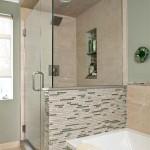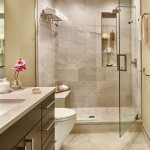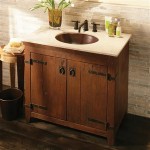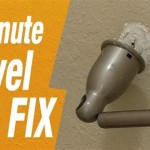How to Get Rid of Mildew on Bathroom Caulk
Mildew, a common household fungus, thrives in damp and poorly ventilated environments, making bathroom caulk a prime target. The porous nature of caulk allows moisture to penetrate, creating a breeding ground for mildew spores. While mildew is primarily a cosmetic issue in its early stages, if left untreated, it can lead to more significant problems, including potential health concerns and degradation of the caulk itself, ultimately requiring replacement. This article outlines effective methods for removing mildew from bathroom caulk, preventing its recurrence, and maintaining a clean and healthy bathroom environment.
Before attempting any mildew removal method, it is essential to identify the substance correctly. Mildew typically appears as flat, discolored patches, often white, gray, or yellow. It is distinct from mold, which tends to be fuzzy, raised, and can be black, green, or brown. While both thrive in similar conditions, mold often indicates a more serious moisture problem and may necessitate professional remediation. If there is any doubt about whether the growth is mildew or mold, particularly if the growth is extensive or accompanied by a musty odor, consulting a professional is advised.
The success of mildew removal depends on several factors, including the severity of the infestation and the type of caulk used. Some methods are more effective than others and may require multiple applications to achieve satisfactory results. Safety precautions should always be observed, including wearing gloves and eye protection to prevent skin and eye irritation. Proper ventilation is also crucial to minimize exposure to cleaning agents and mildew spores.
Identifying Mildew and Assessing the Infestation
The first step in addressing mildew on bathroom caulk is accurate identification. Mildew typically presents as a surface discoloration, often appearing as small, flat spots that gradually spread. It is crucial to differentiate mildew from mold, as mold often indicates a more significant moisture intrusion issue. Mold is typically more textured and may have a musty odor, whereas mildew is generally odorless or has a slightly musty smell.
Once identified as mildew, the extent of the infestation needs to be assessed. Mildew confined to a small area on the surface of the caulk is generally easier to remove than mildew that has penetrated deeper into the caulk. If the mildew has been present for an extended period, it may be deeply embedded and require more aggressive cleaning methods or even replacement of the caulk. Inspecting the surrounding areas for signs of moisture or water damage can also help determine the underlying cause of the mildew growth.
A visual inspection of the bathroom is necessary. Look for areas where water tends to accumulate, such as around the showerhead, faucet, or along the edges of the bathtub or shower stall. Check for signs of leaks or drips, as these can contribute to the moisture that promotes mildew growth. Pay attention to ventilation; a poorly ventilated bathroom will trap moisture and increase the likelihood of mildew formation.
Effective Cleaning Methods for Mildew Removal
Several cleaning methods are effective for removing mildew from bathroom caulk, ranging from simple household solutions to more potent chemical cleaners. The choice of method depends on the severity of the mildew and personal preference.
1. Vinegar Solution: White vinegar is a natural and effective cleaning agent for mild mildew infestations. Its acidity helps to kill mildew spores and prevent regrowth. To use vinegar, simply pour undiluted white vinegar into a spray bottle. Spray the vinegar directly onto the mildewed caulk, ensuring it is thoroughly saturated. Allow the vinegar to sit for at least one hour, or preferably overnight, to allow it to penetrate the mildew. After soaking, scrub the caulk with a stiff-bristled brush or an old toothbrush to remove the mildew. Rinse the area thoroughly with water and dry with a clean towel.
2. Baking Soda Paste: Baking soda is another natural cleaning agent that is effective for removing mildew. It is also a mild abrasive, which can help to scrub away stubborn mildew stains. To create a baking soda paste, mix baking soda with water until it forms a thick paste. Apply the paste to the mildewed caulk and let it sit for at least 30 minutes. Scrub the area with a brush or sponge, then rinse it thoroughly with water and dry it with a clean towel. Baking soda is a good alternative for those sensitive to the strong smell of vinegar.
3. Bleach Solution: Bleach is a powerful disinfectant that is highly effective for killing mildew. However, it should be used with caution, as it can be harsh on surfaces and can release harmful fumes. When using bleach, always wear gloves and eye protection and ensure adequate ventilation. To create a bleach solution, mix one part bleach with ten parts water. Apply the solution to the mildewed caulk using a sponge or spray bottle. Allow the solution to sit for 10-15 minutes, but no longer, as prolonged exposure can damage the caulk. Scrub the area with a brush, then rinse it thoroughly with water and dry it with a clean towel. Never mix bleach with ammonia or other cleaning agents, as this can create toxic fumes.
4. Hydrogen Peroxide: Hydrogen peroxide is a gentler alternative to bleach that is still effective for killing mildew. It is also less likely to discolor surfaces. To use hydrogen peroxide, spray it directly onto the mildewed caulk and let it sit for 10-15 minutes. Scrub the area with a brush, then rinse it thoroughly with water and dry it with a clean towel. For stubborn stains, you can mix hydrogen peroxide with baking soda to create a paste.
5. Commercial Mildew Removers: Numerous commercial mildew removers are available on the market. These products are specifically formulated to kill mildew and remove stains. When using a commercial mildew remover, it is important to follow the manufacturer's instructions carefully. Always wear gloves and eye protection and ensure adequate ventilation. Some commercial mildew removers may contain harsh chemicals, so it is important to test the product on an inconspicuous area of the caulk before applying it to the entire surface.
Preventing Mildew Recurrence and Maintaining Caulk
After successfully removing mildew from bathroom caulk, preventing its recurrence is crucial to maintaining a clean and healthy bathroom environment. Several preventive measures can be implemented to minimize moisture and inhibit mildew growth.
1. Improve Ventilation: Adequate ventilation is essential for preventing mildew growth. Ensure that the bathroom is well-ventilated by opening windows or using an exhaust fan during and after showers or baths. Leaving the bathroom door open can also help to improve air circulation. If the bathroom lacks adequate ventilation, consider installing a more powerful exhaust fan.
2. Dry Surfaces After Use: After showering or bathing, use a squeegee or towel to dry the walls, shower door, and caulk around the bathtub or shower. This helps to remove excess moisture and prevent mildew from forming. Pay particular attention to areas where water tends to accumulate.
3. Regularly Clean the Bathroom: Regular cleaning of the bathroom helps to remove mildew spores and prevent them from taking hold. Clean the bathroom surfaces, including the caulk, at least once a week using a mild soap and water solution. For areas prone to mildew, such as the shower and bathtub, consider using a mildew-resistant cleaner.
4. Seal Leaks and Repairs: Address any leaks or drips promptly to prevent moisture from accumulating. Check faucets, showerheads, and pipes for leaks and repair them as soon as possible. Ensure that the caulk around the bathtub, shower, and sink is properly sealed and free from cracks or gaps. If the caulk is damaged or peeling, remove it and re-caulk the area.
5. Use Mildew-Resistant Caulk: When replacing caulk, choose a mildew-resistant product. These caulks contain additives that inhibit the growth of mildew. While mildew-resistant caulk is not completely immune to mildew, it can significantly reduce the likelihood of its formation. Follow the manufacturer's instructions carefully when applying mildew-resistant caulk.
6. Maintain Proper Humidity Levels: Maintaining proper humidity levels in the bathroom can help to prevent mildew growth. High humidity levels create a favorable environment for mildew to thrive. Consider using a dehumidifier to reduce humidity levels in the bathroom, especially during humid months. Aim to keep humidity levels below 50%. Monitoring humidity levels with a hygrometer can help.
By implementing these preventive measures, it is possible to significantly reduce the risk of mildew recurrence on bathroom caulk and maintain a cleaner, healthier bathroom environment. Routine maintenance and vigilance are key to preventing mildew problems and extending the life of the caulk.
In cases where mildew is deeply embedded in the caulk and resistant to cleaning, or if the caulk is severely damaged, replacement may be the only viable option. Removing old caulk requires careful scraping and cleaning to ensure a smooth surface for the new application. Applying a thin, even bead of mildew-resistant caulk and allowing it to cure properly according to the manufacturer's instructions is essential for long-term protection.

How To Remove Mold From Shower Caulk Or Tile Grout Fabulously Clean
How To Remove Mold From Caulk Frugally

How To Get Mold Out Of Shower Caulk Hometalk

I Found Mold In The Shower Caulking What Should Do

How To Remove Silicone Caulking All Trades Las Vegas

Here S How Remove And Replace Mildewed Bathroom Caulk

How To Replace Bathroom Caulking Remove Mold Completely Diy Re
How To Remove Mold From Caulk Frugally

Black Mold In The Shower Here S How To Remove It Help For You

How To Re Caulk Your Tub
Related Posts







